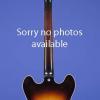One of the Very Earliest Silver Jets
This 13 1/4-inch-wide guitar weighs in at just 7.40 lbs. and has a nice, fat nut width of well over 1 11/16 inches and a scale length of 24 1/2 inches. Chambered mahogany body, pressed arched top with silver sparkle plastic laminate, one-piece mahogany neck, and white-bound Brazilian rosewood fretboard with 22 frets and inlaid pearloid block position markers. Headstock with inlaid pearl Gretsch "T-roof" logo. Four-ply binding (white/black/white/black) on the top of the guitar. Individual Grover StaTite open-back tuners with oval metal buttons. Two single-coil DeArmond Dynasonic pickups with outputs of 3.55k and 3.70k. Four-layer (white/black/white/black) plastic pickguard. Four controls (two volume and one tone on the lower treble bout and one master volume control on the treble horn), plus a three-way pickup selector switch on upper bass bout. The pots are stamped "134 335" and "134 343" (Centralab, August and October 1953). Chrome knobs with cross-hatch pattern on sides and unengraved flat tops. Black Melita Synchro-Sonic bridge with chrome saddles on ebony base and chrome cut-out "G-hole flat" tailpiece. This is one of the very earliest Silver Jets, with the serial number "13014" printed on a label inside the control cavity with the model number still designated as "6128." The serial number is also engraved on the outside of the control cavity cover. Apart from some minor surface loss due to belt buckle wear on the back of the body, this is an exceptionally clean and totally original example with one of the fattest baseball bat necks we have ever seen. It has all of of the very earliest features, including block inlays, the original black Melita bridge, chrome knobs with no "G through arrow," plain four-layer plastic pickguard (with no pickup cut-outs), and of course that neck! There are none of the usual negative issues with the binding on this guitar and the sparkle top is in absolutely perfect condition. Housed in the original straw-colored fitted case with maroon plush lining and the original "Gretsch" ribbon (9.25).
Gretsch serial numbers for 1955 began with "13000" -- this is the fourteenth guitar produced that year.
"In 1953 Gretsch launched its first solidbody, the single-cutaway Duo Jet. In fact, the guitar was a semi-solid with routed channels and pockets inside, but the visual effect was certainly of a solidbody instrument. In its early years the new Duo Jet had, unusually, a body front covered in a black plastic material, as used on some Gretsch drums. It also had Gretsch's unique two-piece strap buttons (an early take on the idea of locking strap buttons) and the Melita Synchro-Sonic Bridge" (Tony Bacon, Electric Guitars: The Illustrated Encyclopedia, pp. 163-165).
"1954's 6128 Duo Jet and the Model 6129 Silver Jet were fraternal twins… The 6128's shiny sibling the Model 6129 Silver Jet bears precisely the same characteristics as its black brother with the obvious exception, of course, of its silver sparkle Nitron drum material top. Preeminently collectible on today's vintage guitar market, the Silver Jet occasionally appears with a factory-original, fixed-arm Bigsby B-3 aluminium vibrato tailpiece combined, not with a Bigsby bridge, but a chrome-plated Melita. Bigsby tailpieces were not standard on any Jet-series guitar (they were stock on the model 6121 Chet Atkins Solidbody) but could be custom-ordered at the player's request and at extra charge; this rarely occurred, however. Despite the fact that Gretsch had been making drums since the late-19th Century and offered a wide variety of sparkle, pearl and metallic finishes on them, no single cutaway Model 6129, or any other model number, with a sparkle top other than silver sparkle has been uncovered… Earliest pickguards for 1954 are white plastic without "Gretsch" inscribed on it… Duo Jets and Silver Jets for 1955 looked exactly the same as their 1954 counter parts with the exception of the aforementioned pickguard change: the white, unengraved, uncut 'guard is more globular, rounder than before, is clear Lucite painted silver from the underside, pantograph-engraved on a radius with a black "Gretsch" block letter logo, and is cut to fit around the DeArmond pickups' metal mounting rings." (Jay Scott, Gretsch: The Guitars of the Fred Gretsch Company, pp. 92-93).
Translate:

